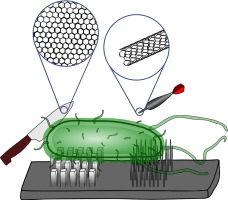Advances in Colloid and Interface Science ( IF 15.6 ) Pub Date : 2017-12-24 , DOI: 10.1016/j.cis.2017.12.007 Nicholas Lin , Paula Berton , Christopher Moraes , Robin D. Rogers , Nathalie Tufenkji

|
Over the past ten years, a next-generation approach to combat bacterial contamination has emerged: one which employs nanostructure geometry to deliver lethal mechanical forces causing bacterial cell death. In this review, we first discuss advances in both colloidal and topographical nanostructures shown to exhibit such “mechano-bactericidal” mechanisms of action. Next, we highlight work from pioneering research groups in this area of antibacterials. Finally, we provide suggestions for unexplored research topics that would benefit the field of mechano-bactericidal nanostructures. Traditionally, antibacterial materials are loaded with antibacterial agents with the expectation that these agents will be released in a timely fashion to reach their intended bacterial metabolic target at a sufficient concentration. Such antibacterial approaches, generally categorized as chemical-based, face design drawbacks as compounds diffuse in all directions, leach into the environment, and require replenishing. In contrast, due to their mechanisms of action, mechano-bactericidal nanostructures can benefit from sustainable opportunities. Namely, mechano-bactericidal efficacy needs not replenishing since they are not consumed metabolically, nor are they designed to release or leach compounds. For this same reason, however, their action is limited to the bacterial cells that have made direct contact with mechano-bactericidal nanostructures. As suspended colloids, mechano-bactericidal nanostructures such as carbon nanotubes and graphene nanosheets can pierce or slice bacterial membranes. Alternatively, surface topography such as mechano-bactericidal nanopillars and nanospikes can inflict critical membrane damage to microorganisms perched upon them, leading to subsequent cell lysis and death. Despite the infancy of this area of research, materials constructed from these nanostructures show remarkable antibacterial potential worthy of further investigation.
中文翻译:

纳米飞镖,纳米刀片和纳米钉:机械杀菌的纳米结构以及在何处找到它们
在过去的十年中,出现了一种对抗细菌污染的下一代方法:采用纳米结构的几何结构来传递致命的机械力,从而导致细菌细胞死亡。在这篇综述中,我们首先讨论胶体和形貌纳米结构的进展,这些结构显示出这种“机械杀菌”的作用机理。接下来,我们将重点介绍抗菌领域开拓性研究小组的工作。最后,我们为有益于机械杀菌纳米结构领域的未探索的研究课题提供了建议。传统上,在抗菌材料中加入抗菌剂,期望这些试剂能够及时释放,以达到其预期的细菌代谢目标的足够浓度。这种抗菌方法 通常归类为基于化学物质的表面设计缺陷,因为化合物会向各个方向扩散,会渗入环境中,需要补给。相反,由于其作用机理,机械杀菌纳米结构可从可持续机会中受益。即,由于不需要新陈代谢来消耗机械杀菌功效,也不需要将其设计为释放或浸出化合物。然而,出于同样的原因,它们的作用仅限于与机械杀菌纳米结构直接接触的细菌细胞。作为悬浮的胶体,机械杀菌纳米结构(例如碳纳米管和石墨烯纳米片)可以刺穿或切开细菌膜。或者,诸如机械杀菌的纳米柱和纳米钉之类的表面形貌可能会对栖息在其上的微生物造成严重的膜破坏,从而导致随后的细胞裂解和死亡。尽管该研究领域尚处于起步阶段,但由这些纳米结构构成的材料仍显示出显着的抗菌潜力,值得进一步研究。



























 京公网安备 11010802027423号
京公网安备 11010802027423号